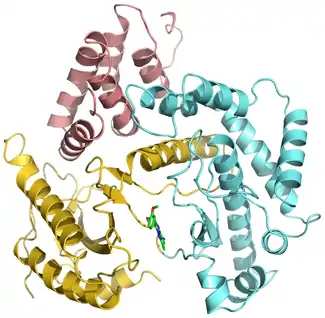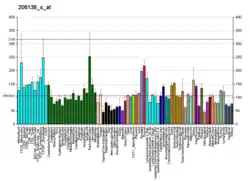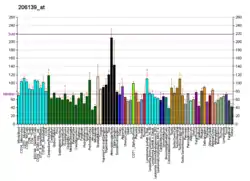PI4KB
Phosphatidylinositol 4-kinase beta is an enzyme that in humans is encoded by the PI4KB gene.[5][6][7]
| PI4KB | |||||||||||||||||||||||||||||||
|---|---|---|---|---|---|---|---|---|---|---|---|---|---|---|---|---|---|---|---|---|---|---|---|---|---|---|---|---|---|---|---|
| |||||||||||||||||||||||||||||||
| Identifiers | |||||||||||||||||||||||||||||||
| Aliases | PI4KB, NPIK, PI4K-BETA, PI4K92, PI4KBETA, PI4KIIIBETA, PIK4CB, phosphatidylinositol 4-kinase beta, PI4KIII | ||||||||||||||||||||||||||||||
| External IDs | OMIM: 602758 MGI: 1334433 HomoloGene: 6741 GeneCards: PI4KB | ||||||||||||||||||||||||||||||
| |||||||||||||||||||||||||||||||
| |||||||||||||||||||||||||||||||
| |||||||||||||||||||||||||||||||
| |||||||||||||||||||||||||||||||
| Wikidata | |||||||||||||||||||||||||||||||
| |||||||||||||||||||||||||||||||
Classification
This gene encodes a phosphatidylinositol 4-kinase which catalyzes phosphorylation of phosphatidylinositol at the D-4 position, yielding phosphatidylinositol 4-phosphate (PI4P). Besides the fact, that PI4P serves as a precursor for other important phosphoinositides, such as phosphatidylinositol 4,5-bisphosphate, PI4P is an essential molecule in the cellular signaling and trafficking especially in the Golgi apparatus and the trans Golgi network.
Phosphatidylinositol 4-kinases are evolutionary conserved among eukaryotes and include four human isoforms
- phosphatidylinositol 4-kinase alpha (PI4KA)
- phosphatidylinositol 4-kinase beta (PI4KB)
- phosphatidylinositol 4-kinase 2-alpha (PI4K2A)
- phosphatidylinositol 4-kinase 2-beta (PI4K2B)
Function
Phosphatidylinositol 4-kinase beta (PI4KB) is a soluble protein shuttling between the cytoplasm and the nucleus,[8] and can be recruited to the membranes of the Golgi system via protein-protein interactions, e.g. with small GTP binding proteins Arf1[9] and Rab11,[10] or a Golgi adaptor protein ACBD3.[11][12] PI4KB can be phosphorylated by the protein kinase D,[13] which promotes the interaction with 14-3-3 proteins and stabilization of the protein in its active conformation.[14] In cytoplasm PI4KB regulates the trafficking from the Golgi system to the plasma membrane, nevertheless, its nuclear function remains to be determined.
Clinical significance
A wide range of positive-sense single-stranded RNA viruses (e.g. picornaviruses) including many important human pathogens hijack human PI4KB kinase to generate specific PI4P-enriched organelles called membranous webs.[15] These organelles are then used as specific platforms for the effective viral replication within the host cell.
Furthermore, PI4KB homologue from the protozoan parasite Plasmodium falciparum has been identified as a target of imidopyrazines, an antimalarial compound class.[16]
Structure
PI4KB is composed of a proline-rich N-terminal region, a central helical domain, and a kinase domain located C-terminally. The N-terminal region contains a physiologically important binding site for a Golgi adaptor protein ACBD3, but is likely disordered and dispensable for the kinase activity. The central helical domain is responsible for the interaction with a small guanosine triphosphatase Rab11. The kinase domain can be divided into N-terminal and C-terminal lobes with the ATP binding groove and putative phosphatidylinositol binding pocket in a cleft between the lobes.[17] In addition, an ALPS motif has been identified in the extreme C-terminal region of PI4KB, which favors its association with unsaturated or loosely packed membranes regions.[18]

References
- GRCh38: Ensembl release 89: ENSG00000143393 - Ensembl, May 2017
- GRCm38: Ensembl release 89: ENSMUSG00000038861 - Ensembl, May 2017
- "Human PubMed Reference:". National Center for Biotechnology Information, U.S. National Library of Medicine.
- "Mouse PubMed Reference:". National Center for Biotechnology Information, U.S. National Library of Medicine.
- Meyers R, Cantley LC (February 1997). "Cloning and characterization of a wortmannin-sensitive human phosphatidylinositol 4-kinase". The Journal of Biological Chemistry. 272 (7): 4384–90. doi:10.1074/jbc.272.7.4384. PMID 9020160.
- Saito T, Seki N, Ishii H, Ohira M, Hayashi A, Kozuma S, Hori T (August 1997). "Complementary DNA cloning and chromosomal mapping of a novel phosphatidylinositol kinase gene". DNA Research. 4 (4): 301–5. doi:10.1093/dnares/4.4.301. PMID 9405938.
- "Entrez Gene: PIK4CB phosphatidylinositol 4-kinase, catalytic, beta polypeptide".
- de Graaf P, Klapisz EE, Schulz TK, Cremers AF, Verkleij AJ, van Bergen en Henegouwen PM (April 2002). "Nuclear localization of phosphatidylinositol 4-kinase beta". Journal of Cell Science. 115 (Pt 8): 1769–75. doi:10.1242/jcs.115.8.1769. PMID 11950893.
- Godi A, Pertile P, Meyers R, Marra P, Di Tullio G, Iurisci C, Luini A, Corda D, De Matteis MA (September 1999). "ARF mediates recruitment of PtdIns-4-OH kinase-beta and stimulates synthesis of PtdIns(4,5)P2 on the Golgi complex". Nature Cell Biology. 1 (5): 280–7. doi:10.1038/12993. PMID 10559940. S2CID 30441132.
- de Graaf P, Zwart WT, van Dijken RA, Deneka M, Schulz TK, Geijsen N, Coffer PJ, Gadella BM, Verkleij AJ, van der Sluijs P, van Bergen en Henegouwen PM (April 2004). "Phosphatidylinositol 4-kinasebeta is critical for functional association of rab11 with the Golgi complex". Molecular Biology of the Cell. 15 (4): 2038–47. doi:10.1091/mbc.E03-12-0862. PMC 379297. PMID 14767056.
- Sasaki J, Ishikawa K, Arita M, Taniguchi K (February 2012). "ACBD3-mediated recruitment of PI4KB to picornavirus RNA replication sites". The EMBO Journal. 31 (3): 754–66. doi:10.1038/emboj.2011.429. PMC 3273392. PMID 22124328.
- Greninger AL, Knudsen GM, Betegon M, Burlingame AL, DeRisi JL (April 2013). "ACBD3 interaction with TBC1 domain 22 protein is differentially affected by enteroviral and kobuviral 3A protein binding". mBio. 4 (2): e00098-13. doi:10.1128/mBio.00098-13. PMC 3622926. PMID 23572552.
- Hausser A, Storz P, Märtens S, Link G, Toker A, Pfizenmaier K (September 2005). "Protein kinase D regulates vesicular transport by phosphorylating and activating phosphatidylinositol-4 kinase IIIbeta at the Golgi complex". Nature Cell Biology. 7 (9): 880–6. doi:10.1038/ncb1289. PMC 1458033. PMID 16100512.
- Hausser A, Link G, Hoene M, Russo C, Selchow O, Pfizenmaier K (September 2006). "Phospho-specific binding of 14-3-3 proteins to phosphatidylinositol 4-kinase III beta protects from dephosphorylation and stabilizes lipid kinase activity". Journal of Cell Science. 119 (Pt 17): 3613–21. doi:10.1242/jcs.03104. PMID 16912074.
- Hsu NY, Ilnytska O, Belov G, Santiana M, Chen YH, Takvorian PM, Pau C, van der Schaar H, Kaushik-Basu N, Balla T, Cameron CE, Ehrenfeld E, van Kuppeveld FJ, Altan-Bonnet N (May 2010). "Viral reorganization of the secretory pathway generates distinct organelles for RNA replication". Cell. 141 (5): 799–811. doi:10.1016/j.cell.2010.03.050. PMC 2982146. PMID 20510927.
- McNamara CW, Lee MC, Lim CS, Lim SH, Roland J, Simon O, Yeung BK, Chatterjee AK, McCormack SL, Manary MJ, Zeeman AM, Dechering KJ, Kumar TS, Henrich PP, Gagaring K, Ibanez M, Kato N, Kuhen KL, Fischli C, Nagle A, Rottmann M, Plouffe DM, Bursulaya B, Meister S, Rameh L, Trappe J, Haasen D, Timmerman M, Sauerwein RW, Suwanarusk R, Russell B, Renia L, Nosten F, Tully DC, Kocken CH, Glynne RJ, Bodenreider C, Fidock DA, Diagana TT, Winzeler EA (December 2013). "Targeting Plasmodium PI(4)K to eliminate malaria". Nature. 504 (7479): 248–253. Bibcode:2013Natur.504..248M. doi:10.1038/nature12782. PMC 3940870. PMID 24284631.
- Burke JE, Inglis AJ, Perisic O, Masson GR, McLaughlin SH, Rutaganira F, Shokat KM, Williams RL (May 2014). "Structures of PI4KIIIβ complexes show simultaneous recruitment of Rab11 and its effectors". Science. 344 (6187): 1035–8. Bibcode:2014Sci...344.1035B. doi:10.1126/science.1253397. PMC 4046302. PMID 24876499.
- Mesmin B, Bigay J, Polidori J, Jamecna D, Lacas-Gervais S, Antonny B (November 2017). "Sterol transfer, PI4P consumption, and control of membrane lipid order by endogenous OSBP". The EMBO Journal. 36 (21): 3156–3174. doi:10.15252/embj.201796687. PMC 5666618. PMID 28978670.
Further reading
- Balla A, Balla T (July 2006). "Phosphatidylinositol 4-kinases: old enzymes with emerging functions". Trends in Cell Biology. 16 (7): 351–61. doi:10.1016/j.tcb.2006.05.003. PMID 16793271.
- Balla T (July 2013). "Phosphoinositides: tiny lipids with giant impact on cell regulation". Physiological Reviews. 93 (3): 1019–137. doi:10.1152/physrev.00028.2012. PMC 3962547. PMID 23899561.
- Altan-Bonnet N, Balla T (July 2012). "Phosphatidylinositol 4-kinases: hostages harnessed to build panviral replication platforms". Trends in Biochemical Sciences. 37 (7): 293–302. doi:10.1016/j.tibs.2012.03.004. PMC 3389303. PMID 22633842.
- Minogue S, Waugh MG (2012). The phosphatidylinositol 4-kinases: don't call it a comeback. Subcellular Biochemistry. Vol. 58. pp. 1–24. doi:10.1007/978-94-007-3012-0_1. ISBN 978-94-007-3011-3. PMID 22403072.
- Kutateladze TG (July 2010). "Translation of the phosphoinositide code by PI effectors". Nature Chemical Biology. 6 (7): 507–13. doi:10.1038/nchembio.390. PMC 3182472. PMID 20559318.
- Tan J, Brill JA (2014). "Cinderella story: PI4P goes from precursor to key signaling molecule". Critical Reviews in Biochemistry and Molecular Biology. 49 (1): 33–58. doi:10.3109/10409238.2013.853024. PMID 24219382. S2CID 207506490.






